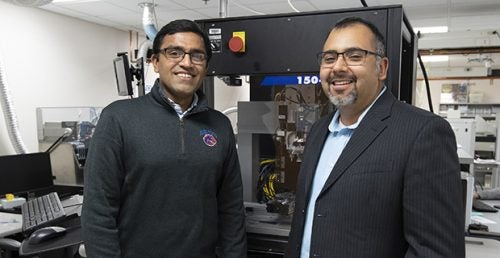A research proposal put forth by Boise State assistant professor Harish Subbaraman and associate professor David Estrada in the College of Engineering, and being led by the Boeing Company, has been selected to receive $100,000 to conduct novel research with flexible hybrid electronics. The project also includes another $100,000 of cost share from Boise State University.

The Boise State project, which was chosen by NextFlex, a Manufacturing USA institute dedicated to furthering the field of flexible electronics, is part of a larger $1.8 million award to expand the field and potential of flexible hybrid electronics. The goal is to print and integrate circuits directly onto the wings or frame of an unmanned aircraft vehicle (UAV), such as a drone.
The challenge? Doing something that has never been done before, in just 15 months. Subbaraman, the principal investigator on this project, and his team will be using an additive manufacturing approach to print electronic materials directly onto a UAV mainframe.
“Instead of having something that’s as rigid as a traditional integrated circuit, the contents will be thin, where you could actually bend them and flex them without losing any kind of performance characteristics,” said Subbaraman. “The end goal would be to have flexible batteries, flexible solar cells, everything, on the mainframe, so that now you have a fully self-powered, light-weight system.”
This research would make it possible to reduce the weight and drag of traditional, rigid electronics on the UAV, making them lighter and more efficient. Subbaraman views the research as an exciting step towards realizing the possibilities for flexible hybrid electronics, especially for persons with disabilities.
He wants to use flexible hybrid electronics/optoelectronics to help people. “For example, a visually impaired person now requires a cane; if you could have electronics, cameras built into clothing, all GPS enabled, it could give cues to turn, so that the person wouldn’t need a stick anymore,” said Subbaraman.
Concurrently with this project, Subbaraman will be teaching a course on flexible electronics and creating opportunities for students to garner experience working with cutting-edge flexible electronics research.
“Our membership in NextFlex has strengthened our partnerships with Boise-based American Semiconductor – a global leader in flexible silicon integrated circuits – Air Force Research Labs and NASA,” said Estrada. “Our students have earned national recognition at the FLEX Conference for their work on printed and flexible electronics. Our collaborators are constantly seeking out our students for internships and full time employment, highlighting the quality education they are gaining in the field of flexible hybrid electronics here at Boise State.”
The FLEX Conference is the nation’s premier conference for flexible electronics, which highlights recent advances in fundamental materials science and new applications of printed and flexible electronics.
Boise State has been a member of the NextFlex Consortium since 2015. Through the consortium, the university has developed significant expertise in printed and flexible hybrid electronics, resulting in more than $2 million in research funding for printed and flexible electronics from Nextflex, NASA and the Department of Energy.